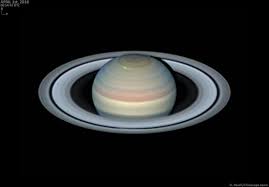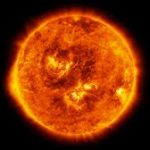Saturn- A Unique Planet with Rings
Saturn earned its name from Saturnus, the Roman god of agriculture and father of Jupiter. The existence of the planet Saturn is known to man since pre-historic times and has figured in many mythical stories.
Saturn – The jewel of the solar system
Saturn is the sixth planet in the solar system from the sun and second largest after Jupiter. It is adorned by a dazzling system of icy rings. This feature makes Saturn unique among all planets in appearance, though it is not the only planet to have rings. The complex and spectacular rings of Saturn keep it apart from other planet and helped earning the name “ the jewel of the solar system”. The beautiful, most massive and visible ring system of Saturn is not a continuous solid system. It is like a blizzard in orbit around the planet’s equator consisting of particles of rock and ice of different sizes. The rings are made of billions of such particles orbiting around the planet like miniature moons. The ring is expected to have thickness of one kilometer. They are very wide and the width of main rings could almost span from earth to Moon. There are seven rings of which three are visible from Earth. These rings are separated by divisions that consist of particles that are less densely packed than the highly visible rings. The ring systems of Jupiter, Uranus and Neptune are not as bright or big as that of Saturn.
It is less dense compared to other planets and probably only planet that could float in water, as it is made of gas. The planet is home to the most fascinating landscapes in the solar system. Just like Jupiter, Saturn too is gas planet consisting mainly of hydrogen and helium. Lot of mysteries surrenders Saturn and many of these are yet to unfold.
Rotation of Saturn and the seasons
Saturn is rotating at a distance of around 1,426, 978,000 km from the sun. It has an equatorial diameter of 120,536 km and polar diameter of 106,900 km. It takes 10 hours and 14 minutes to compete one rotation and around 29.4 years (10759 days) for one revolution round the sun. While Earth is composed of rock and metal, Saturn consists of gas. But, similar to earth’s 23.5 degree tilt, Saturn’s axis is titled by 26.73 degrees with respect to its orbit around the sun. Hence, Saturn too undergoes seasonal changes.
Saturn and its moons
Saturn has more than 60 natural satellites (moons) that revolve around it. Mimas, a ball of ice with 396 km in diameter is the closest one, orbiting at a distance of 1,85,540 km. Dione, Titan, Rhea, Tethys and Enceladus are the major moons of the planet. Phoebe, at a distance of 13 million kilometers from the planet orbits in opposite direction to other natural satellites. Titan, which is bigger than Mercury in size, is the only natural satellite in solar system to have an atmosphere.
Explorations to Saturn
Despite the distance being a villain, man has tried to study Saturn. The distance between the orbits of Saturn and Earth is eight times the distance between Earth and the sun. Pioneer 11 (1979), Voyager 1 ( 1980) and Voyager 2 (1981) of NASA have studied Saturn, its rings and moons. The Cassini and Huygens space probe, a collaboration between NASA and the European Space Agency , entered orbit around Saturn on July 1, 2004 and identified eight new satellites. Its mission ended on September 15, 2017 when it performed a number of passes through gaps between the planet and its inner rings and finally entered the atmosphere of Saturn.
What are the features of planet mercury?
Is water body detected on Mars?









